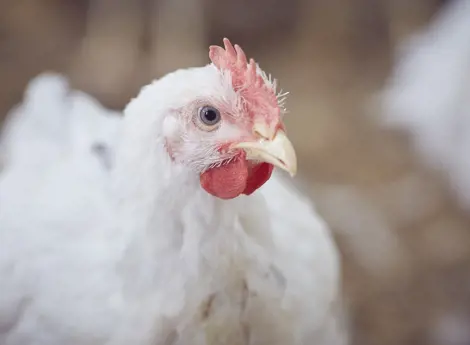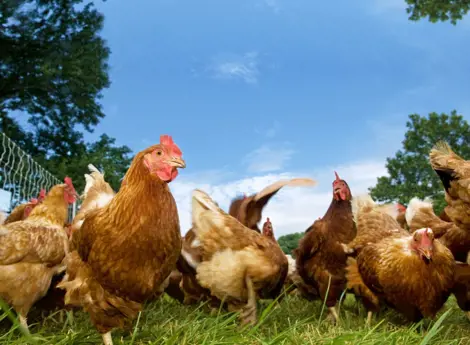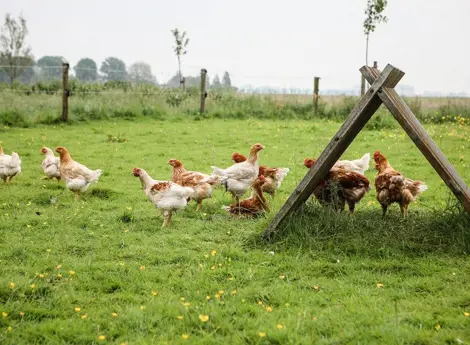Broiler breeder nutrition part II – What is the impact on the offspring?
In the previous article, we explained the effect of nutrition on the performance of broiler breeders. In this article, we will review some of the results of the offspring from these breeders. The results discussed here are a selection of the outcomes from the comprehensive research project performed by our Global Poultry R&D Department together with Wageningen University.
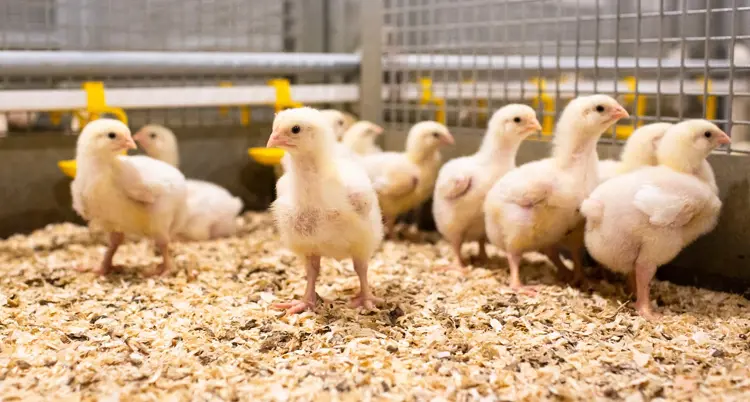
For more details, please take a look at the previous article.
By studying the complete lifecycle of two generations, we might improve broiler breeder production as well as the efficiency of commercial broiler chick production. Therefore, the question is: can we improve the performance of day-old chickens by adapting maternal breeder nutrition?
Set up of the experiment
The experiment was conducted using 1.536 female Ross 308 breeders from day 1 of life until 60 weeks of age. The setup involved a 2 by 4 factorial design, incorporating two growth curves: the standard breeding guide growth curve (SGC) and an elevated growth curve (EGC) to achieve body weights 15% above the breeding target. Within each growth curve, 4 different diets with varying energy (AME) to protein ratios were fed. At 28 and 36 weeks of age, 60 clean and settable hatching eggs per pen were selected and placed in an incubator (a total of 1.440 eggs)
Hatching of the eggs was done by distributing the selected 60 eggs per breeder pen, evenly over one setter tray. These setter trays were randomly divided into 3 blocks within the incubator (located at the top, middle, and bottom of the trolley). On day 18, eggs with viable embryos were chosen. The selected eggs were then transferred, per setter tray, to a single hatching basket. These hatching baskets were randomly placed on trolleys across the top, middle, bottom, back, and front of the trolley. Subsequently, the trolley was positioned in another incubator.
During the last days before pulling the eggs, the incubator was opened every 6 hours to check if the chicks had hatched. After hatching, the chicks were marked, and their quality was assessed. First-grade chicks were transferred to another similar incubator and placed in 24 hatching baskets until pull. After pulling all chicks were feather sexed and pooled per maternal treatment and sex.
A total of 384 female and 384 male first-grade chicks were used from each maternal breeder age (28 and 36 weeks of age). On day 0, the chicks were randomly assigned to one of the 64 floor pens within 4 blocks. Each pen contained 6 female and 6 male chicks, all from the same maternal treatment. In total 8 pens were allocated per treatment. On day 7, one male and one female chick were removed from each pen for post-mortem study. At 14 days of age, 2 adjacent pens were merged, resulting in 4 pens per treatment.
All broilers were fed the same standard commercial diets following a 4-phase feed program, see table 1. The performance of the broilers was recorded from day 1 until slaughter.
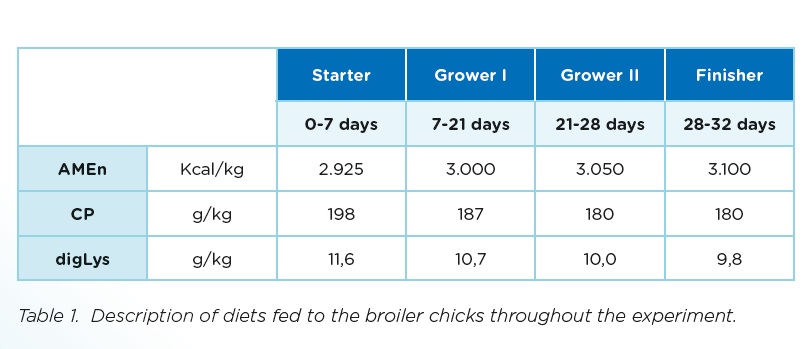
Results and implications
Previously, we learned that heavier broiler breeders produce heavier eggs, as mentioned in the Koudijs Newsletter from June 2023. During incubation, eggs from the heavier breeders showed a slightly lower egg weight loss (numerically). However, embryonic mortality did not seem to be connected with breeder body weight. Interestingly, an increasing dietary energy-to-protein ratio led to a reduction in very early embryonic mortality (within the first 3 days of incubation).
An overview of the assessed chick quality parameters is presented in table 2. Reviewing these results, it appears that the offspring of heavier breeders have a higher hatchling weight as well as yolk-free body mass. No differences can be detected in other parameters except for a higher percentage of navel score 2 in chicks from the heavier breeders. Interestingly, an increasing energy-to-protein ratio in the breeder diets resulted in lower hatchling weight. Thus, with a higher protein intake by the breeder, both egg and hatchling weight increased. No interaction between the weight and diet of breeders was observed in the results on chick quality, except concerning the navel score.
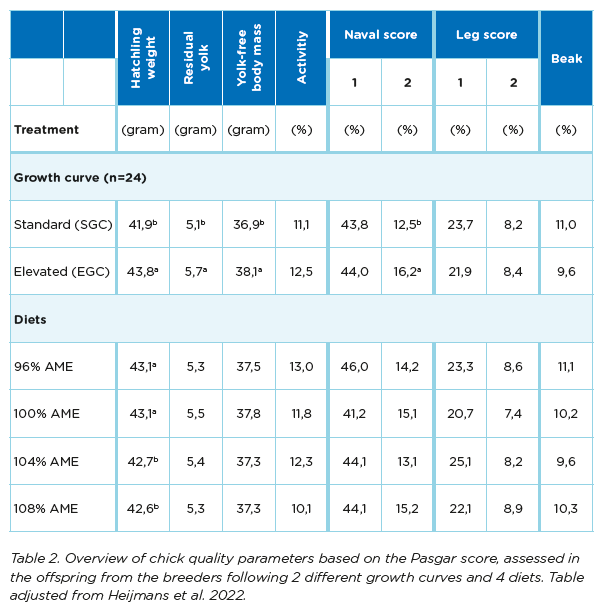
Maternal influence on offspring performance
Finally, when reading the results described in table 3, the maternal influence on offspring performance seems evident. Chicks from the heavier breeders were heavier at hatch and showed a higher average daily gain (ADG), resulting in a higher slaughter weight. Even the carcass yield (% of body weight) was higher in the chicks from the heavier breeders.
Moreover, it can be confirmed that the maternal diet composition influences chick performance. Chicks of breeders fed a higher dietary energy-to-protein ratio are shown to have higher daily growth, increased feed intake, and a reduced FCR (see data in 3). In other words, these chicks are more efficient.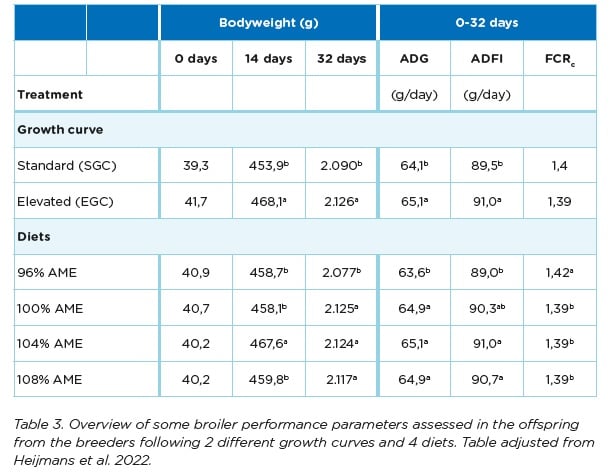
This research was conducted as part of the PhD project of Jesse Heijmans, poultry researcher, in collaboration with Wageningen University, the Netherlands
Conclusions and take-home
Clearly, maternal influence on offspring can be confirmed. A higher female breeder body weight leads to higher egg, hatchling, and slaughter weights of their offspring. No significant difference can be noted in FCR and corrected FCR due to breeder body weight.
Furthermore, maternal diet affects the performance of their chicks. Chicks of breeders fed a higher dietary energy-to-protein ratio become more efficient, showing improved growth, feed intake, and FCR.
Taken together, the study indicates that breeder nutrition should be a part of the overall nutritional strategy when reviewing chick performance. Depending on the situation, it may be beneficial to stimulate a higher body weight in female breeders. When a higher slaughter weight and improved carcass yields of the offspring are the goals of production, it may also pay off to fatten the broiler breeders.
Curious if the breeders in your production chain are fat enough?
Let's review your broiler (breeder) nutritional strategy together with one of our Poultry Specialists.
About the author

Maria Saras-Johansson
Specialist Poultry
Do you have any questions or would you like more information? Get in touch with Maria.



